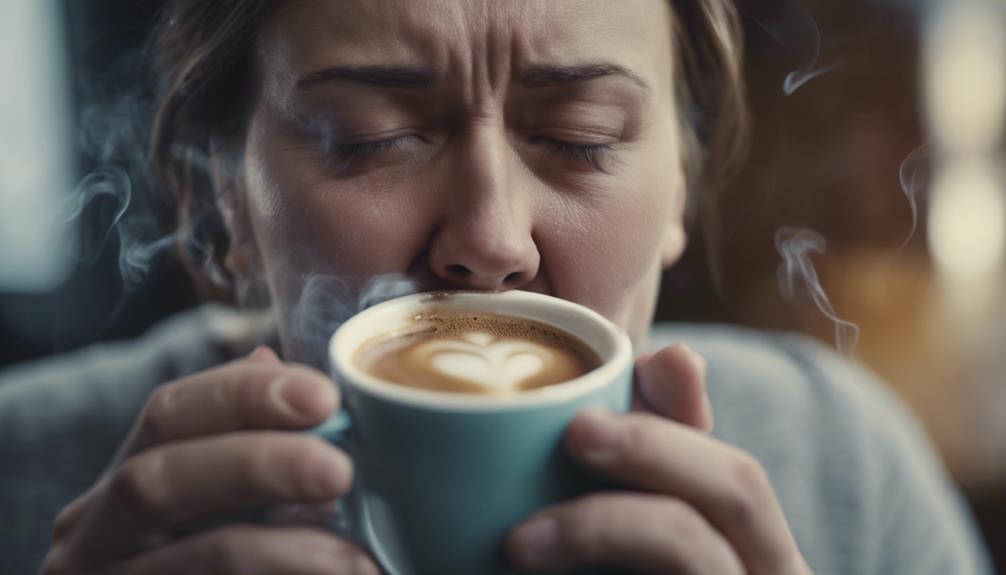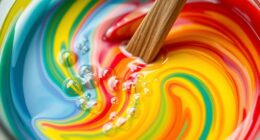After having your wisdom teeth removed, it is best to avoid drinking coffee for the first 2 days. Consuming coffee too soon can increase the risk of bleeding by interfering with blood clot formation and irritating the extraction site due to its high temperature and acidity. Waiting approximately 2 weeks before having coffee again will allow the site to heal properly. The impact of caffeine could impede the healing process by affecting blood pressure and dislodging important blood clots. By focusing on healing rather than immediate coffee consumption, you can support a smoother recovery. Remember, following your dentist’s recommendations is crucial for a successful healing process.
Key Takeaways
- Wait at least 2 days before consuming coffee post-wisdom teeth removal.
- Coffee can disrupt blood clot formation and increase bleeding risk.
- Avoid hot coffee initially to prevent irritation and complications.
- Coffee's acidity can delay healing; limit intake for optimal recovery.
- Opt for lukewarm or cold brew coffee after adequate healing time.
Effects of Coffee on Healing
Refraining from coffee for at least two days after wisdom teeth removal is essential to support the healing process and reduce the risk of complications. Drinking coffee after tooth extraction can have detrimental effects on the overall healing of the extraction site. The caffeine in coffee increases the risk of bleeding by disrupting blood clot formation, which is vital for proper healing.
Additionally, the high temperatures of hot coffee can irritate the extraction site, potentially dislodging the blood clot and hindering the healing process.
It is imperative to avoid coffee post-extraction to promote excellent oral health and prevent complications such as dry socket. The acidity of coffee further delays the healing process, making it crucial to abstain from consuming it during the initial recovery period.
Timing of Coffee Consumption

Wait at least two days before even contemplating sipping on coffee following wisdom teeth removal. Giving your mouth time to heal without the interference of coffee can aid in the recovery process.
Sensitivity and the potential impact of coffee on the post-extraction healing process are important factors to ponder.
Post-Extraction Healing Process
For essential healing after wisdom teeth removal, it's best to refrain from consuming coffee for at least two days post-extraction. During the post-extraction period, the healing process is vital for a smooth recovery.
Coffee after tooth extraction can hinder this process by disrupting the formation of the blood clot, which is vital for proper healing and recovery. It's recommended to wait around two weeks before reintroducing coffee into your diet to make sure that the extraction site has had enough time to heal adequately.
If you experience any pain or swelling after the procedure, it's important to contact your dentist promptly to monitor your healing progress. Following specific guidelines for what to eat and drink after tooth extraction, such as avoiding straws and intense exercise, can also contribute to a more comfortable and efficient recovery process.
Prioritizing your post-extraction care will help promote excellent healing and reduce the risk of complications.
Consideration of Sensitivity
To enhance your post-wisdom teeth removal healing process, it's important to be mindful of when you choose to consume coffee. Sensitivity in the area where your wisdom teeth were extracted is vital to take into account when thinking about having coffee. Dentists typically recommend waiting around two days before indulging in your favorite brew. Drinking coffee too soon can impede the healing process and increase the risk of complications.
It's best to err on the side of caution and wait for about two weeks for complete recovery before reintroducing coffee into your routine. The timing of coffee consumption plays a significant role in the development of a blood clot and overall healing. If you experience any pain, swelling, or signs of infection, it's crucial to contact your dentist before resuming coffee intake.
Being patient and allowing your body to heal properly will benefit your overall recovery process and minimize the chances of any setbacks.
Caffeine's Impact on Recovery

Consuming coffee post-wisdom teeth removal can hinder your healing process due to caffeine's impact on blood pressure and blood vessel dilation. This can pose risks such as dislodging or dissolving the blood clot, essential for proper recovery.
It's important to be mindful of the timing and potential negative effects of coffee consumption to promote a smooth healing journey post-surgery.
Caffeine and Healing
Limiting caffeine intake is essential for promoting the best healing after wisdom teeth removal due to its potential negative impact on the recovery process. Coffee, a common source of caffeine, can hinder the healing of the extraction site by increasing blood pressure, thereby raising the risk of post-extraction bleeding.
Caffeine's effects on blood vessel dilation can further complicate the healing process by potentially dislodging the vital blood clot that forms after the procedure. This clot is vital for proper healing and protection of the underlying tissues.
By consuming coffee or other caffeinated beverages, you may inadvertently prolong your recovery time and increase the likelihood of experiencing complications. Hence, it's crucial to avoid caffeine intake, including coffee, to ensure a smooth and uneventful healing process after wisdom teeth removal. Can coffee affect tooth extraction? Yes, consuming coffee can actually slow down the healing process and potentially lead to post-operative complications. The stimulant effect of caffeine can increase blood pressure and heart rate, which may disrupt the blood clot formation and increase the risk of dry socket. Therefore, it’s important to adhere to your dentist’s instructions and avoid caffeine intake to promote optimal healing after wisdom teeth removal.
Prioritizing your health by steering clear of caffeine will help promote the best healing and reduce the risk of post-operative issues.
Timing of Consumption
Avoid coffee consumption immediately after wisdom teeth removal to support a smooth and uncomplicated healing process. The timing of consumption is essential as caffeine's impact on recovery can be significant. Refraining from coffee for at least two days post-extraction is recommended to avoid hindering the healing process.
Caffeine, present in coffee, can elevate blood pressure and potentially dislodge the blood clot essential for proper healing. To guarantee a successful recovery, it's safest to wait approximately two weeks before reintroducing coffee into your diet. Please be aware that the effects of coffee on blood clot formation and healing processes may vary depending on individual recovery progress.
If you experience any pain, swelling, or complications related to coffee consumption after wisdom teeth removal, it's advisable to consult your dentist promptly. Prioritizing the timing of coffee consumption post-extraction can contribute to a successful recovery and minimize risks associated with disrupting the healing process.
Potential Risks Involved
Be cautious about the impact of caffeine on your recovery after wisdom teeth removal when considering drinking coffee. Caffeine, a common component of coffee, can have detrimental effects on your healing process post-extraction.
Here are some potential risks involved:
- Critical for Blood Clot: Caffeine can interfere with blood clot formation, which is essential for proper healing after wisdom teeth removal.
- Increased Risk of Complications: The dilation of blood vessels caused by caffeine can elevate the risk of bleeding and potentially dislodge the essential blood clot, leading to complications.
- Irritation and Dry Socket: The acidity and temperature of coffee can irritate the extraction site, increasing the chances of developing dry socket, a painful condition that delays healing.
To avoid these risks, it's advisable to follow your dentist's instructions and wait at least two days before reintroducing coffee post-extraction. Prioritizing your healing process over immediate coffee consumption can help ensure a smoother recovery without unnecessary complications.
Risks of Drinking Hot Coffee

Drinking hot coffee following wisdom teeth removal poses significant risks to your healing process. The heat from the hot beverage can disrupt the formation of the essential blood clot in the extraction site, hindering proper healing.
Exposing the extraction area to high temperatures can lead to irritation and discomfort, potentially increasing the risk of complications such as dry socket. Additionally, the heat from hot coffee can elevate bleeding in the tooth removal site, prolonging the recovery period and causing unnecessary discomfort.
It's advisable to steer clear of hot coffee for at least the initial 24-48 hours post-wisdom teeth extraction to facilitate optimal healing and reduce the likelihood of complications.
Acidity and Extraction Sites

Avoid exacerbating the healing process of your extraction sites by being mindful of the acidity present in coffee, which can potentially impede proper recovery post-wisdom teeth removal. Here are some key points to keep in mind:
- Coffee's acidity: Irritates sensitive extraction sites, delaying wound healing.
- Increased risk of complications: The acidity in coffee can heighten the chances of issues like dry socket.
- Disruption of blood clot formation: Exposure to acidic substances like coffee can interfere with the essential formation of blood clots in the extraction sites.
Balancing your desire for coffee with the need for proper oral recovery is important to prevent complications after wisdom teeth removal. Understanding how acidity impacts extraction sites is vital for a smooth and successful healing process. Be cautious with acidic beverages like coffee to promote successful healing and reduce the risk of post-extraction complications.
Cold Coffee Considerations

Consider refraining from consuming cold coffee immediately after wisdom teeth removal to support optimal healing of your extraction sites. Cold coffee, despite its invigorating taste, can have a negative impact on the healing process following your surgery.
The temperature of cold coffee can disrupt the blood clot that forms in the extraction site, leading to potential irritation and complications. It's recommended to wait at least 72 hours before indulging in lukewarm or cold coffee to make sure the extraction site heals properly.
Caffeine present in cold coffee can also impede the healing process, similar to hot coffee. To err on the side of caution, it's best to avoid cold coffee until your extraction site has mostly healed.
Iced Coffee Recommendations

Iced coffee can be tempting, but it's crucial to take into account the impact on your healing process post-wisdom teeth removal. Cold brew can offer a less acidic option, while being mindful of additions like milk that may increase acidity levels.
Wait until bleeding has subsided before indulging in iced coffee to promote proper healing.
Cold Brew Benefits
For those looking to enjoy coffee after wisdom teeth removal, exploring the benefits of cold brew can be an invigorating option. However, it's crucial to take into account the impact of cold brew on your healing process.
- Cold brew coffee is less acidic than regular hot coffee, which can be gentler on your healing gums.
- Waiting at least 72 hours before consuming lukewarm or cold coffee post-extraction is advisable to minimize complications.
- Iced coffee can increase acidity levels in the mouth, potentially affecting the healing of the extraction site.
Flavorful Additions
To enhance the flavor of your iced coffee post-wisdom teeth removal, try experimenting with non-acidic sweeteners like flavored syrups or coconut milk.
While adding milk to iced coffee can increase its acidity levels, opting for coconut milk can provide a creamy texture without adding to the acidity.
It's important to highlight that cold coffee, including iced coffee, should be avoided after a tooth extraction. Even when diluted with ice, iced coffee may still contain acidity that can potentially hinder the healing process.
Remember to wait at least 72 hours before consuming lukewarm or cold coffee to ensure proper healing.
Instead of cold coffee, consider exploring warm alternatives like lukewarm coffee if you're keen for a flavorful beverage.
Temperature Considerations
Consider waiting at least 72 hours before indulging in cold coffee, such as iced coffee, post-wisdom teeth removal to promote ideal healing. When it comes to temperature considerations for your post-extraction beverages, opting for lukewarm options may be the safest choice.
Here are some recommendations to keep in mind:
- Avoid Iced Coffee: Cold coffee, including iced coffee, can have negative effects on the healing process.
- Acidity Concerns: The acidity in iced coffee can hinder proper blood clot formation and delay healing.
- Wait it Out: Waiting at least 72 hours before considering lukewarm or cold coffee after extraction can help minimize risks to the healing site.
Blood Clot Formation and Acidity

Drinking coffee soon after wisdom teeth removal can potentially delay the formation of an essential blood clot due to its acidity. Research indicates that the acidity present in coffee can increase blood clotting time by up to 25%.
This delay in blood clot formation can hinder the healing process in the extraction site. Hence, immediate consumption of coffee post-extraction may prolong the time required for a stable blood clot to develop, impacting the overall recovery.
It's advisable to refrain from coffee intake for the initial healing period to promote proper blood clot formation and facilitate the healing process. Allowing the blood clot to form undisturbed is vital for protecting the extraction site and preventing complications.
Pain Prevention Strategies

Proper pain prevention strategies post-wisdom teeth removal include applying ice packs to reduce swelling and discomfort. Over-the-counter pain medications like ibuprofen can also alleviate post-extraction pain effectively. Additionally, following a soft diet can prevent aggravating the extraction sites and minimize discomfort.
- Swelling Reduction: Applying ice packs intermittently to the cheeks can help reduce swelling and inflammation around the extraction sites.
- Pain Management: Utilizing over-the-counter pain medications such as ibuprofen as directed by your dentist can effectively alleviate post-extraction pain.
- Healing Process Support: Opting for a soft diet that's easy to chew can aid in promoting proper healing and prevent unnecessary strain on the extraction sites.
Remember to maintain proper oral hygiene by gently rinsing your mouth and avoiding vigorous brushing near the extraction areas to support the healing process effectively. Avoiding hot beverages like coffee is important to prevent any irritation or potential damage to the healing sockets.
Dental Health Protection Tips

To protect your dental health post-wisdom teeth removal, adhere to essential guidelines for a smooth recovery process.
Follow your dentist's instructions diligently to guarantee excellent healing and recovery after a tooth extraction.
Avoid using straws, tobacco, or alcohol for at least 24 hours post-extraction to prevent complications.
Delay rinsing your mouth with saltwater until the day after extraction to promote healing and avoid disrupting the forming blood clot.
Refrain from intense exercise in the first 24 hours after wisdom teeth removal to prevent any disruption to the healing process. Redirecting blood flow from the treatment site by avoiding strenuous activities can help prevent delays in healing.
Remember to follow specific guidelines for eating and drinking post-extraction to support a smooth recovery process and protect your dental health.
Frequently Asked Questions
How Long After Wisdom Teeth Can I Drink Coffee?
After wisdom teeth removal, it's advisable to wait at least two days before enjoying coffee to prevent complications. Dentists generally recommend avoiding coffee for a full two weeks post-extraction to support best healing.
Consuming coffee too soon can interfere with the formation of a blood clot, increasing the risk of dry socket. If you're feeling any pain or swelling, it's important to consult your dentist before resuming coffee intake to guarantee safe recovery.
What Drinks Are OK After Wisdom Teeth Removal?
After wisdom teeth removal, it's best to stick to lukewarm or cold beverages like water or ice chips to prevent complications. Avoid hot or acidic drinks, including coffee, until the extraction site has fully healed.
Opt for soft, non-acidic options such as lukewarm tea or smoothies during the initial recovery period. Follow your dentist's instructions on when it's safe to reintroduce coffee or other potentially irritating beverages after wisdom teeth removal.
When Can I Stop Worrying About a Dry Socket?
You can generally stop worrying about dry socket risk decreasing notably after the first 2-3 days post-extraction.
Proper blood clot formation within the initial 3-5 days is essential to prevent this complication. Following post-extraction care instructions diligently is vital.
What Can I Drink Besides Water After Tooth Extraction?
After tooth extraction, besides water, you can opt for lukewarm or cold beverages like herbal tea, clear broths, fruit juices, milkshakes, or protein shakes to stay hydrated and aid in healing.
Avoid carbonated, caffeinated, and alcoholic drinks as they can hinder the recovery process. Choosing nutrient-rich options will support your healing journey without risking complications.
Remember to follow your dentist's recommendations for a smooth recovery experience.
Conclusion
In summary, consuming coffee after wisdom teeth removal can hinder healing due to its acidity and potential impact on blood clot formation.
While iced coffee may be a safer option, it's best to consult with your dentist before indulging.
Remember, prioritizing proper pain management and dental health protection is vital for a smooth recovery.
So, sip cautiously and stay vigilant to guarantee a successful healing process post-extraction.









